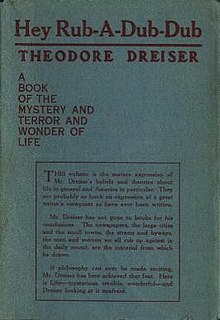Hey Rub-a-Dub-Dub
 First edition | |
| Author | Theodore Dreiser |
|---|---|
| Country | United States |
| Language | English |
| Genre | philosophy |
| Publisher | Boni & Liveright |
Publication date | 1920 |
Hey Rub-a-Dub-Dub: A Book of the Mystery and Wonder and Terror of Life is a collection of twenty essays by Theodore Dreiser.
Contents[]
- "Hey Rub-a-Dub-Dub"
- "Change"
- "Some Aspects of Our National Character"
- "The Dream"
- "The American Financier"
- "The Toil of the Laborer"
- "Personality"
- "A Counsel to Perfection"
- "Neurotic America and the Sex Impulse"
- "Secrecy-Its Value"
- "Ideals, Morals, and the Daily Newspaper"
- "Equation Inevitable"
- "Phantasmagoria"
- "Ashtoreth"
- "The Reformer"
- "Marriage and Divorce"
- "More Democracy or Less? An Inquiry"
- "The Essential Tragedy of Life"
- "Life, Art and America"
- "The Court of Progress"
Literary significance and criticism[]
Six essays and one play had already been published in newspapers prior to this collection.[1]
Keith Newlin has argued that Hey Rub-a-Dub-Dub follows in the wake of Dreiser's attempts at philosophy, which he had started in his 1916 book called and ended with , published posthumously in 1974.[1]
The collection was castigated by reviewers from the New York Evening Post, the and The New Republic, though Dreiser held it in high regard.[1] Carl Van Doren pointed out Dreiser's inability to sustain his arguments.[2] H.L. Mencken lampooned it.[3]
The book draws upon Jacques Loeb's The Mechanistic Conception of Life (1912).[4]
References[]
- ^ a b c Keith Newlin, A Theodore Dreiser Encyclopedia, Westport, Connecticut: Greenwood Press, 2003, p. 189 [1]
- ^ Carl Van Doren, The American Novel, Read Books, 2006, p. 255
- ^ Vincent Fitzpatrick, H. L. Mencken, Mercer University Press, 2004, p. 51 [2]
- ^ Jeremy Loving, The Last Titan: A Life of Theodore Dreiser, Berkeley, California: University of California Press, 2005, p. 283 [3]
- 1920 books
- Books by Theodore Dreiser
- Philosophy books
- Philosophy book stubs
- Essay stubs